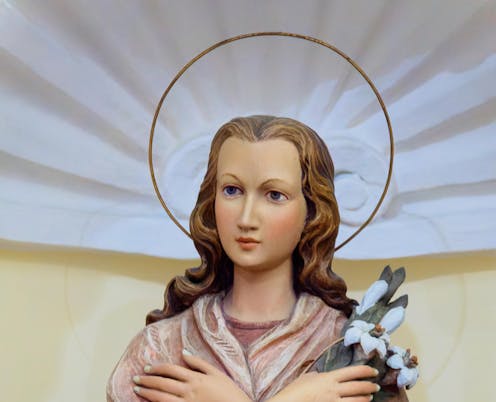Little World, what are you? Josephine Rowe’s latest novel is a precisely drawn enigma
- Written by Tony Hughes-d'Aeth, Professor, Chair of Australian Literature, The University of Western Australia

The unusual element of Josephine Rowe’s short novel Little World is that the heroine remains utterly impassive throughout the events of the narrative. This is for the simple reason that she is dead.
This does not mean she does not act, though. In fact, she acts exactly in the way that the dead are wont to do, which is to present themselves in the form of a question to the living.
Irina, if that is indeed her name, was born in Panama in the townships that serviced the canal at some point early in the 20th century. Her life came to its end at the tender age of 14, whereupon something miraculous occurred: her body failed to decay. Or as it is put in the novel, there is “a failing of entropy”.
The inexorable passage of this incorruptible body gives this strange, spare story its shape.
Review: Little World – Josephine Rowe (Black Inc.)
The novel begins with the girl’s body arriving by horse float at the remote home of Orrin Bird, somewhere near Broome, not long after the second world war. The perfectly preserved human form has been bequeathed to Orrin by his recently departed friend Kaspar Isaksen, whom he had met when the two worked on Nauru in the 1930s.
Isaksen had brought the girl’s body from Panama to Nauru in the hope that he might help with her canonisation. Though he is not religious, Orrin sees no other course than to hold on to the girl’s body, hoping that the termites will not devour the coffin. He lives on for another 17 years, protecting and being protected by his dead yet undead companion. When he dies, the house falls into disrepair, but the girl remains preserved in her incorruptible state.
The situation in Little World is of a still more radical quality, in that the feminine centre remains embalmed and immobile. Because Irina is silent and unmoving, it is impossible to draw on her words or actions to interpret her views or intentions. We are restricted to tentative inferences that stem from her appearance – “appearance” meaning, in this context, not so much how she looks, but how she comes to appear in the places that she appears.
Her incorruptible female body represents a paradox, because it has the quality of an announcement – a wordless comment on her surroundings. Her arrival into the scene resembles the visitation of a saintly personage. Those before her stand in mute awe. She is there to deliver her silent message and she stays until that message has worked itself into the recipients.
Irena’s trajectory takes her from the Panama Canal – that marvel of civil engineering that quietly violates the sanctity of oceans and continents – across the Pacific to Nauru, where she lies beside the industrial dismantling of the island. (Before it became the centrepiece of Australia’s offshore gulag archipelago, Nauru had its pristine surface hacked into a tropical moonscape by a century of extractive phosphate mining.)
From there, Irena travels to Australia and into the bemused possession of Orrin, a man who had tried to disappear in the outback. She found him all the same.
What message she delivers to him we never quite know. Nor to Kaspar either. All we know is that she outlasts both of them. And then she waits once more, while Matti, a figure from the margins of 1970s, moves unwittingly from one side of the continent to the other. Again, we do not know the message that Irina has for Matti, or if Matti will ever know its contents.
Oceanic realisation
In the end, it falls to Matti to free the girl: “She knows only that it is for her alone to right something.”
Leaving her friends stranded in the nearest town, Matti commandeers their van and rigs up the horse float. She drives headlong to the sea, crashing and bumping her way in a singular derangement. There, she releases the girl into the ocean.
This moment of oceanic realisation is the decisive point in the novel. The story doesn’t end there, but its unendingness ends there. The body’s lacquer dissolves and the ocean flows through its tissues and vessels. This event is unwitnessed – it seems it must remain foreclosed to sight – but is instead imagined in touching detail:
The water will press in, against the frail seal of eyelids and lips, rushing past the small teeth and flooding the speechless mouth with brine, spilling on into airways, down the long-dormant corridors of arteries, fallow passageways, to reach the dry hollows of lungs and stomach, the empty ventricles of the silent, fist-sized muscle
the ocean like a great hand opening inside her
Her own hands unclenching in response
Why is it Matti who is called upon to release the girl? Why could neither of the grizzled men, who had held her conscientiously enough in their care before they died, perform this simple act? This is probably the central question of Little World.
The answer the novel offers is that Matti resembles the girl. Both have struggled through a world which had little care for them. The relentless and premature sexual attention of men has blighted their lives. As well as being the object of this external hunger, which must be constantly repelled, there is also a gnawing and all-consuming internal hunger in Matti. This hunger is the concentration of Matti’s being:
Her hunger was its own clarifying force, a secret but not, not anymore a shameful one. She had decided, long ago, to form an allegiance with it.
Indeed, the key correspondence in the novel is between Matti’s hunger and the way the dead girl insinuates herself into the arms of reluctant men. These men hold the girl on the condition that they cannot touch her. Their intimacy depends on the fact that she is already a corpse.
These principles form the strict, perverse coordinates of the novel. But the ethical dimension of Little World is also quite clear. The whole novel orchestrates a sequence of meetings that culminate in Matti consigning the dead girl to a proper death. Little World is a novel for those who find satisfaction in precisely drawn enigmas. The lyricism of the novel is often exquisite, but still more impressive is its fidelity to the dream logic that provides the story with its insistence.
Authors: Tony Hughes-d'Aeth, Professor, Chair of Australian Literature, The University of Western Australia





